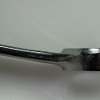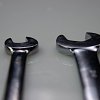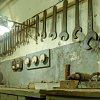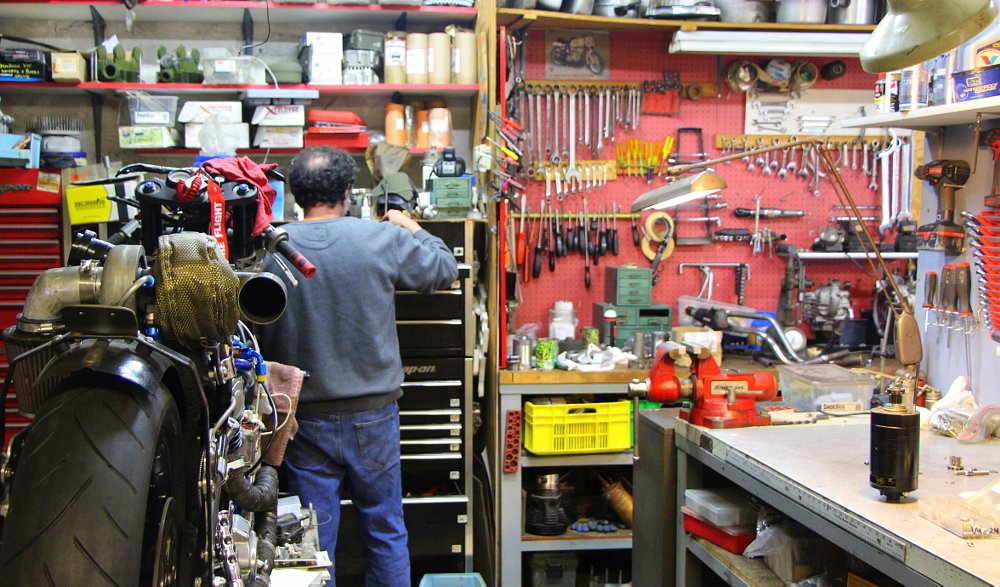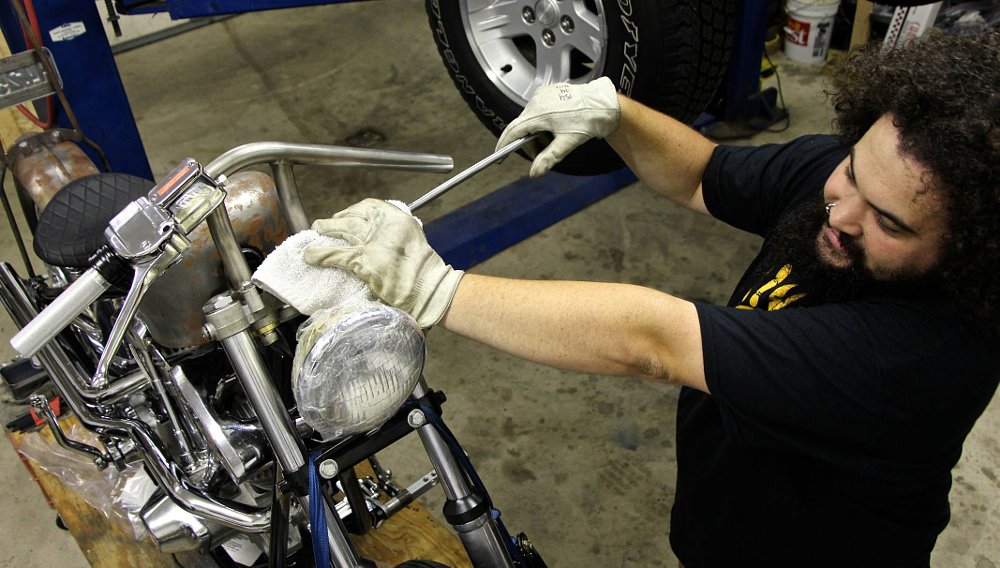If you don’t turn wrenches for a living, you’ve probably given little thought to their design.
If you do turn wrenches, you likely have a deep and meaningful relationship with your tools and strong opinions about things you do and do not want in a wrench. Mechanics — particularly auto and cycle mechanics — are so reliant upon these tools that the laborer frequently refers to himself as a wrench, his oft-used tool. If you spin bolts on your motorcycle, knowing how your tools are built will help you get the most out of them, so I’m going to tell you a little more about the humble combination wrench.
The combination wrench is identified by size
Duh? The number on the wrench, be it 14mm or ⅝, is the distance between the jaws on the open end, which correspond to the distance between parallel flats on the fastener’s head. A shop tip: this can be handy for quick rough measurements. The open end of the wrench is actually sized just a touch loose by a few thou to speed you along as you work on things. Cheaper wrenches often cheat that number up, making the open ends particularly awful to work with. This has not always been the case. I mention this because older tool sizes often referenced the nominal fastener shank diameter. If you are using modern tools, however, the size references the distance between parallel faces on the fastener’s hex head (the distance between the jaws).

And though it may seem obvious, wrench size is directly related to the tool's length. The reason smaller wrenches are shorter isn’t just aesthetic so they look nice hanging on the pegboard; it’s practical, too. Smaller fasteners can bear less torque than big’uns, and by reducing the leverage your big dumb arm can exert, the tool designers reduce the odds you bust somethin’ important. (Long and short wrenches are available, of course.)
The combination wrench has two ends
That’s what makes it a combination wrench. Normally, there will be a box end (a closed, 12-point end) and an open end (a two-sided, U-shaped end). The combination wrench is different from either an open or box wrench in that both ends are for the same size fastener head, meaning switching between ends for the same fastener where access is reduced (like all over your motorcycle!) is possible, rather than requiring two separate tools. The relates a bit to the previous point. Double-open or double-box wrenches almost never are set up to handle the same size fastener at both ends. (There's no need for that, and in most cases would be a waste of money and space.) This is the reason the combination wrench is the go-to tool for pro motorcycle mechanics: If you can't get a fastener spinning with the box end, you probably will be able to access it with the open end. Allow me to explain.
The two ends allow two different ways to approach the fastener’s head in close quarters. The open end permits zero-offset (in terms of the hex head’s plane) access to a hex fastener, but only grips two flats. The box end requires some vertical clearance (in terms of the hex head’s plane), but allows greater torque to be applied than the open end, as it grips the fastener on more faces.

The box end of the wrench will generally be loosely based upon two overlapped hex patterns to allow a greater ability to approach a fastener that is located in an area with reduced swing. (There’s that reduced access again!) This is normally the end of the wrench one will use when clearance is good as it grabs the fastener more positively. Because of this, the box end generally has an head offset angle of 15 degrees or so. Why? Clearance. For your knuckles. If there was no offset, you’d scrape and smash your knuckles as you used the more common end of the wrench. The engineers know you’re using this end of the wrench because you have some clearance in the plane of the fastener’s axis, so they made it more comfortable for you, the user!
Contrast this with the open end of the wrench. On the open end, you’ll usually have zero head offset angle, with the understanding this end is used less frequently in scenarios with little or no clearance in the plane of the fastener’s axis. Instead, offset here is generally in the angle of the opening of the jaws relative to the longitudinal axis of the wrench. Almost always, that angle will be 15 degrees — and the reason for that is, to me, deeply satisfying.

A 15-degree positive offset becomes a 15-degree negative offset if the wrench is flipped over, for a total of 30 degrees. Because there are six flats on a hex head, each flat can move 60 degrees before the hexagon’s position is “reset.” (i.e., oriented the same as when it started, with a different flat in the same position). By flipping a wrench over with each turn, the two-jaw open end has the ability to tighten or loosen a fastener. If the offset were any different, it would be possible for the fastener to get “stuck,” or unable to be turned in a limited-clearance area.
If you’re confused, this video illustrates the concept well.

Why a wrench meant to turn hex-head fasteners is not hex-shaped at either end
If your wrenches had a hex-shaped hole in them, they would be kind of awful to use. It would take a pretty long time to perfectly align the hole in the box end of the wrench and the fastener. If the hole was made loose enough to make that easy, it would likely be loose enough to damage the points of the fastener, and if you encountered well-used fasteners, you’d be replacing or reshaping them a lot. But we don’t have those problems with modern combination wrenches, and that’s not accidental. Counterintuitively, the best way to turn a hexagon-shaped fastener is not with a hexagon-shaped tool.
We discussed earlier the open end of the wrench. That “U” shape engages two of the parallel flats on the fastener, so obviously that end of the wrench ain’t hex-shaped. And the twelve-pointed box end? Well, for starts, it's twelve-pointed to offer twice the number of angles to get at a fastener in a limited-swing area, kind of like how the open end is offset. But even still, it appears that the box end is a pair of hexagons overlaid. I know the box end of your combo wrenches might look hex-y. But odds are excellent they are not.
The reason is that perfect hexes tend to drive just the corners of a fastener. That in turn deforms them, putting undue wear on those corners. To avoid this, it becomes necessary to drive the flank, or flats, of the fastener. This is done by way of radiused corners to allow for off-corner engagement of the fastener. This lobular design has been used in sockets for a long time, and was first patented for wrenches in 1961 by Kelsey-Hayes. The principle has been improved and riffed upon many times over the years and has given rise to many proprietary names you are probably familiar with — Flank Drive, SureGrip, Surface Drive, and a few flavors of spline drives come to mind. (Some of these are great, some are copies, and some are awful.)
Suffice it to say that the best way to turn a hex-head fastener ain’t with a hex-head wrench.

The combination wrench is almost always chrome
There’s a Harley joke in here somewhere. Chrome-plating was invented in 1924, and it was commonly applied to tools just a few short years later. Chrome is resistant to grease, oil, and dirt, cleans up beautifully, and is attractive and easy to care for. It protects the steel of the tool, does not rust easily, and is very hard and protective. If you run into a very old wrench, it's likely to be unfinished, and nowadays about the only option you'll find to chrome is black oxide, which you can see pictured in this article.

Texture matters, too
If you want to get a bunch of mechanics arguing, and the ol’ “What oil should I use in my bike?” ain’t working, ask if the group prefers raised panel wrenches, then duck. Raised panel wrenches are either easier or harder to grab, depending on who you ask, and feel either better or worse against the hand. To save money, the whole wrench is chromed, but normally only the raised panel receives any polishing, leaving a distinctly different feel against the hand than the (usually more expensive) fully polished pieces.


Part of this is due to economy: It’s lots easier to stamp several different brand names into the raised panel if a supplier is producing tools for another brand. Further, chrome is very durable stuff, regardless of whether or not it’s been polished out, but getting that mirror shine requires a mirror-smooth surface, adding cost to the tool (but not durability).
For a long time in the United States, raised panel wrenches were often DIY-quality, and full-polish, contoured pieces were for the pros. That’s changed a bit, now, with some imported RP pieces being very high quality and some full-polish tooling ringing in very inexpensively, but opinions hang around, warranted or not, and I think full-polish pieces are still the more desirable option for many.
Normally, the profile and contour of the wrenches matter, too. A big, bulky head and wrench body might physically work, but in tight quarters, the extra material matters. And think about a tool you might be interacting with thousands of times a day: The details start to matter when something you have to use is clunky.
Those are a few of the ins and outs of the wrench. Basic? Maybe. But there’s a bit more to your average combination wrench than meets the eye. Personally, I couldn’t imagine a more apt tool to eponymously sum up my career, and my suspicion is that I'm not alone in that sentiment.






